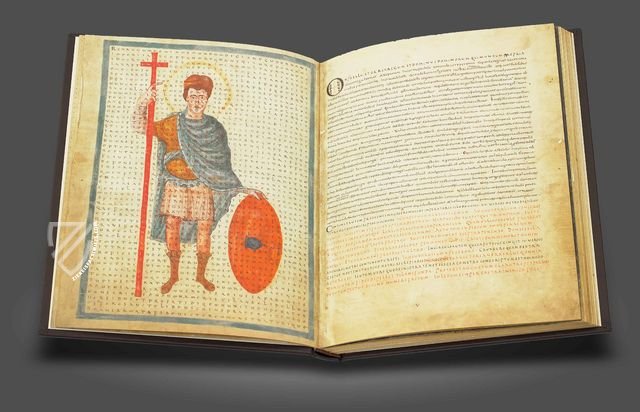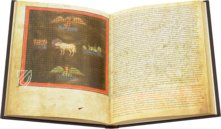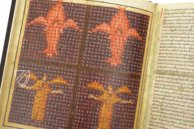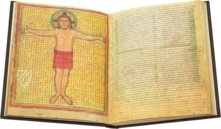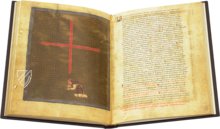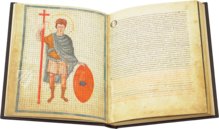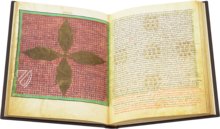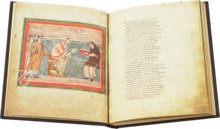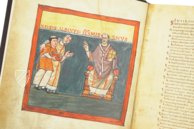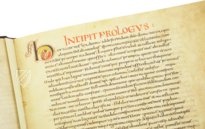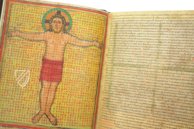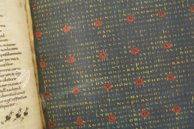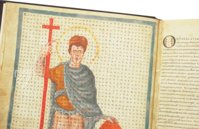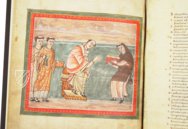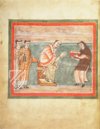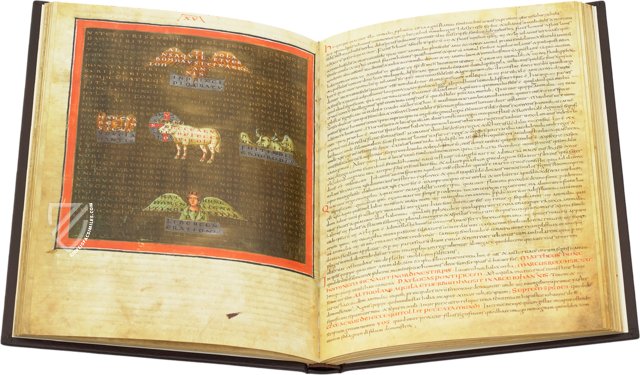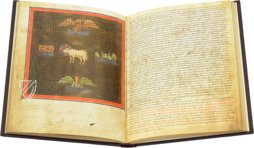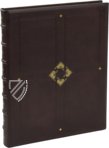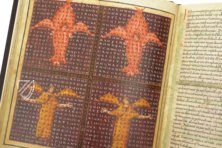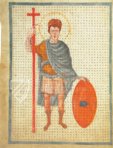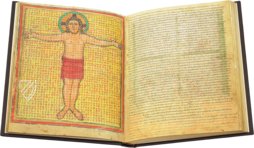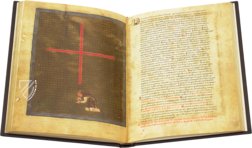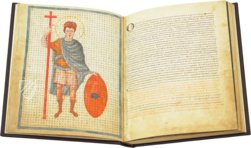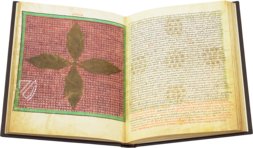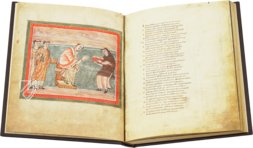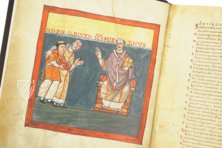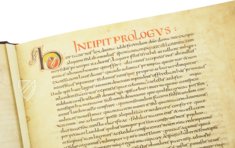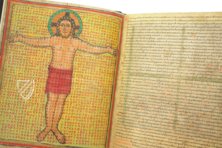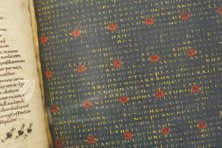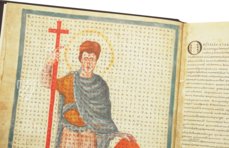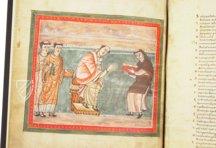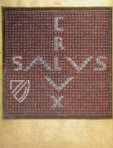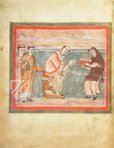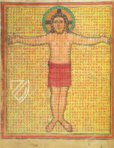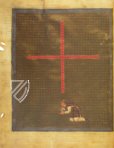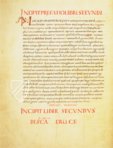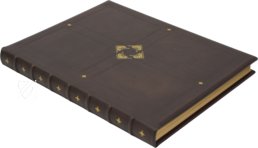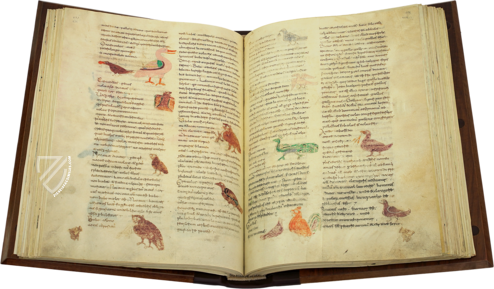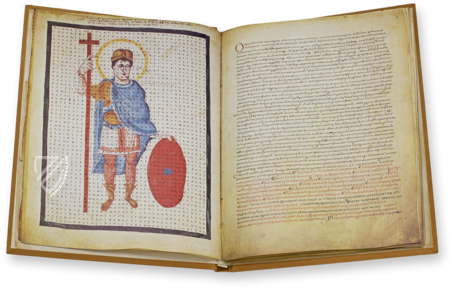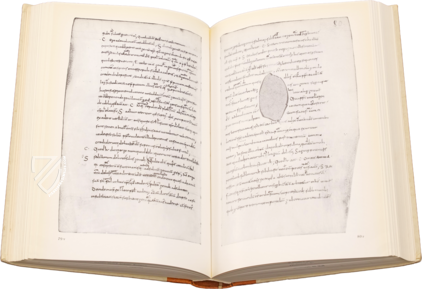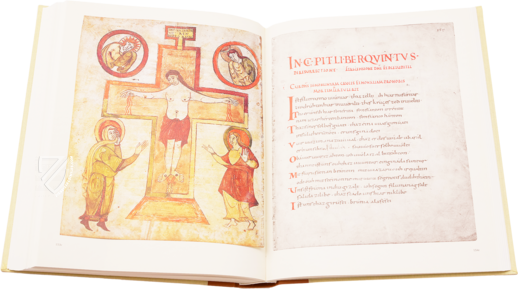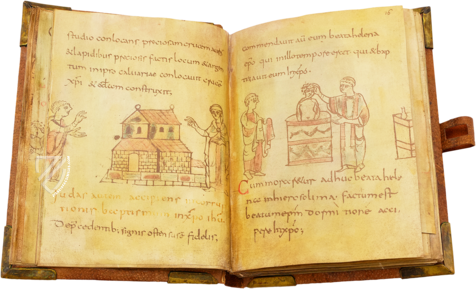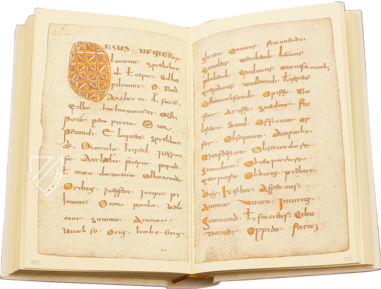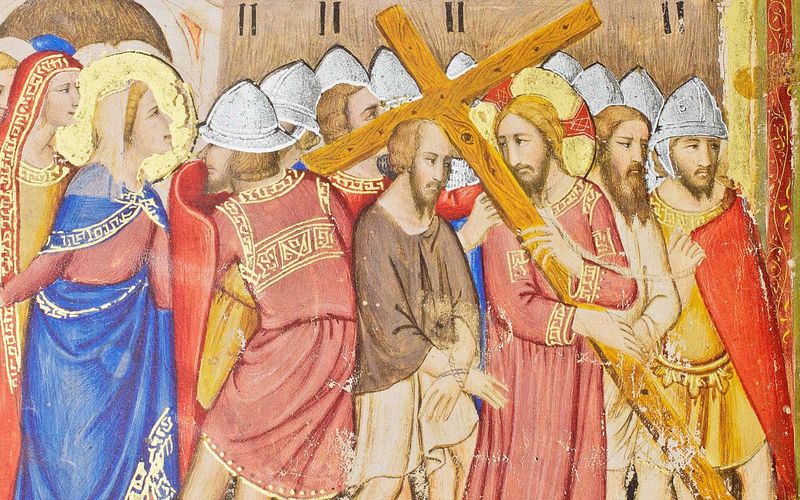De Laudibus Sanctae Crucis
(1,000€ - 3,000€)
Already hailed as the Praeceptor Germaniae in his own time, Hrabanus Maurus (ca. 780-856) was a Frankish monk, Bishop of Mainz, and a prolific author of the Carolingian Renaissance. One of his most popular works is the Liber de laudibus sanctae Crucis, a series of sophisticated carmina figurata - shaped poems - in the style of the great Alcuin, his famous teacher. Originally written ca. 810-14, the 28 intricate picture poems are sort of like biblical word-jumbles containing individual letters and groups of letters which compose self-contained poems or sequences of words that open up several levels, always referring to the basic concept of the composition, the glorification of the Cross. The Vatican Library preserves probably the finest surviving specimen of this masterpiece of religious poetry, written around 825 in the monastery of Fulda and dedicated to the Archbishop Otgar of Mainz.
De Laudibus Sanctae Crucis
Hrabanus Maurus (ca. 780–856), a monk from Fulda who eventually became Bishop of Mainz, achieved great fame for his work Liber de laudibus sanctae Crucis, which was widely-distributed throughout the Carolingian Empire. It contains a series of 28 picture poems taken from the first version of the treatise on the Holy Cross written by Hrabanus as early as 810–14. In fact, some 80 manuscripts of the work survive, many of them made during the lifetime of Hrabanus in the monastery of Fulda. The finest and most artful of these originates from ca. 825/826 is stored today in the Biblioteca Apostolica Vaticana under the shelf mark Reg. Lat. 124 and even features black- and purple-dyed pages.
Fantastic Visual Poetry from the Carolingian Royal Court
Hrabanus, praised at his time as the praeceptor Germaniae, wrote this book in the literary form of picture poems as was formerly practiced in Tours by Alcuin, his famous teacher. Hrabanus raised this literary genre to a new peak, referring less to recent Carolingian models than to the classical source of this form. The text, inscribed on a grid-like system, is presented in a square frame in the manner of a picture. From this text box emerge individual letters and groups of letters which compose self-contained poems or sequences of words referring to the basic concept of the composition, the glorification of the Cross.
A Coveted Hrabanus Manuscript
This copy may have been originally intended for Haistulf (825) the Archbishop of Mainz but was dedicated to his successor Otgar (d. 847) after his death. It remained in the Mainz Cathedral Library before returning to Fulda Monastery at an unknown time. A letter dated June 15th, 1598 indicates that the manuscript was borrowed from Fulda by Emperor Rudolf II (1552-1612), who had it brought to his court in Prague where the manuscript was copied. It was then captured by the Swedes in the course of the Thirty Years’ War (1618-48). It came into the possession of Queen Christina of Sweden (1626-89), who succeeded her father Gustavus Adolphus (1594-1632) after his death in the Battle of Lützen when she was only 18 years old. Christina created a scandal when she announced her intention never to marry, then abdicated her throne, converted to Catholicism, and moved to Rome where she became a celebrity patron of the arts. Her library, including the Hrabanus manuscript, was bequeathed to Pope Innocent XI (1611-89) upon her death and thus came into the possession of the Vatican.
Codicology
- Alternative Titles
- Kreuzeslob
Hrabanus Maurus - De Laudibus Sanctae Crucis - Size / Format
- 124 pages / 36.5 × 29.5 cm
- Origin
- Germany
- Date
- First half of the 9th century
- Epochs
- Style
- Language
- Script
- Carolingian Minuscule Uncial
- Illustrations
- 4 full-page miniatures; 28 picture poems
- Content
- Hrabanus Maurus' De laudibus sanctae crucis (On the Praise of the Holy Cross); Dedication Poem to Gregory the Great; Dedication Poem to Emperor Louis the Pious
- Artist / School
- Hrabanus Maurus (author)
- Previous Owners
- Christina, Queen of Sweden (1626–1689)
De Laudibus Sanctae Crucis
Presentation Miniature
Rooted in classical traditions of patronage, presentation miniatures were an important feature of Late-Carolingian and Ottonian manuscripts that provide important and often unique portraits of various emperors, kings, popes, abbots, and important clerics from this period. Depicted as balding with a little patch of hair on his forehead, Pope Gregory IV is shown enthroned and graciously receiving the manuscript at hand from Hrabanus Maurus, pictured on the right.
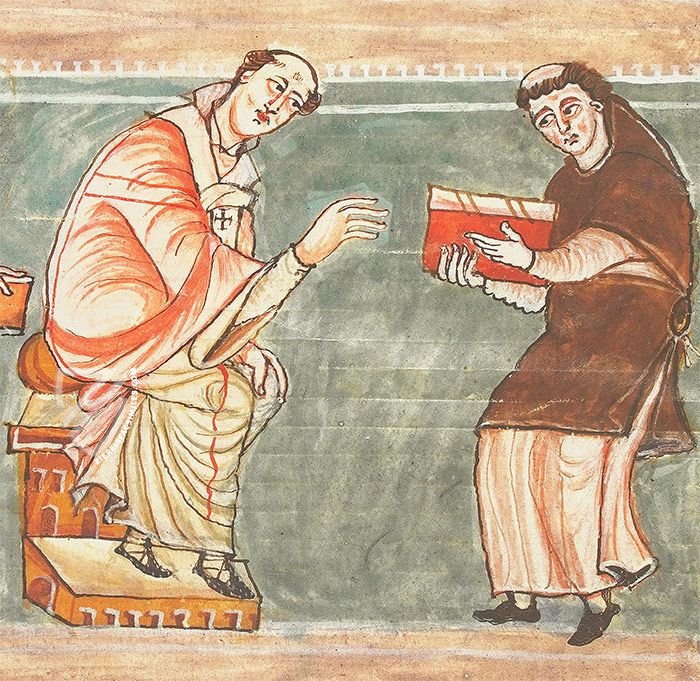
De Laudibus Sanctae Crucis
Calligram of Louis the Pious
This fine Carolingian work was created while the First Iconoclasm occurred in the Byzantine Empire and there was a similar discussion about religious imagery among the Franks. It is filled with picture poems concerning the veneration of the cross like this image presenting the Emperor Louis the Pious (778–840) in the form of a milites Christi or “Soldier of Christ”.
The text of this figure poem is inscribed in a grid pattern, which contains self-contained poems or sequences of words glorifying the cross as a symbol of salvation. Louis is presented in the garb of a Roman soldier with an oval shield from Late Antiquity. The New Testament is filled with references to the Imperial Roman army emphasizing courage, loyalty, and dedication among Christians.
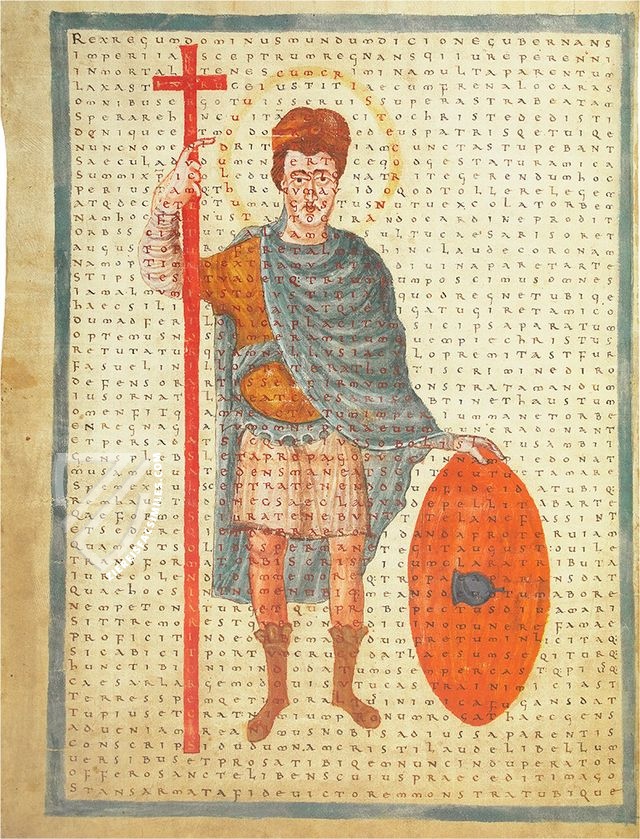
#1 Kreuzeslob. Frühmittelalterliche Bildgedichte. Hrabanus Maurus. Reginensis Latinus 124.
Language: German
(1,000€ - 3,000€)
- Treatises / Secular Books
- Apocalypses / Beatus
- Astronomy / Astrology
- Bestiaries
- Bibles / Gospels
- Chronicles / History / Law
- Geography / Maps
- Saints' Lives
- Islam / Oriental
- Judaism / Hebrew
- Single Leaf Collections
- Leonardo da Vinci
- Literature / Poetry
- Liturgical Manuscripts
- Medicine / Botany / Alchemy
- Music
- Mythology / Prophecies
- Psalters
- Other Religious Books
- Games / Hunting
- Private Devotion Books
- Other Genres
- Afghanistan
- Armenia
- Austria
- Belgium
- Belize
- Bosnia and Herzegovina
- China
- Colombia
- Costa Rica
- Croatia
- Cyprus
- Czech Republic
- Denmark
- Egypt
- El Salvador
- Ethiopia
- France
- Germany
- Greece
- Guatemala
- Honduras
- Hungary
- India
- Iran
- Iraq
- Israel
- Italy
- Japan
- Jordan
- Kazakhstan
- Kyrgyzstan
- Lebanon
- Liechtenstein
- Luxembourg
- Mexico
- Morocco
- Netherlands
- Palestine
- Panama
- Peru
- Poland
- Portugal
- Romania
- Russia
- Serbia
- Spain
- Sri Lanka
- Sweden
- Switzerland
- Syria
- Tajikistan
- Turkey
- Turkmenistan
- Ukraine
- United Kingdom
- United States
- Uzbekistan
- Vatican City
- A. Oosthoek, van Holkema & Warendorf
- Aboca Museum
- Ajuntament de Valencia
- Akademie Verlag
- Akademische Druck- u. Verlagsanstalt (ADEVA)
- Aldo Ausilio Editore - Bottega d’Erasmo
- Alecto Historical Editions
- Alkuin Verlag
- Almqvist & Wiksell
- Amilcare Pizzi
- Andreas & Andreas Verlagsbuchhandlung
- Archa 90
- Archiv Verlag
- Archivi Edizioni
- Arnold Verlag
- ARS
- Ars Magna
- ArtCodex
- AyN Ediciones
- Azimuth Editions
- Badenia Verlag
- Bärenreiter-Verlag
- Belser Verlag
- Belser Verlag / WK Wertkontor
- Benziger Verlag
- Bernardinum Wydawnictwo
- BiblioGemma
- Biblioteca Apostolica Vaticana (Vaticanstadt, Vaticanstadt)
- Bibliotheca Palatina Faksimile Verlag
- Bibliotheca Rara
- Boydell & Brewer
- Bramante Edizioni
- Bredius Genootschap
- Brepols Publishers
- British Library
- C. Weckesser
- Caixa Catalunya
- Canesi
- CAPSA, Ars Scriptoria
- Caratzas Brothers, Publishers
- Carus Verlag
- Casamassima Libri
- Centrum Cartographie Verlag GmbH
- Chavane Verlag
- Christian Brandstätter Verlag
- Circulo Cientifico
- Club Bibliófilo Versol
- Club du Livre
- CM Editores
- Collegium Graphicum
- Collezione Apocrifa Da Vinci
- Comissão Nacional para as Comemorações dos Descobrimentos Portugueses
- Coron Verlag
- Corvina
- CTHS
- D. S. Brewer
- Damon
- De Agostini/UTET
- De Nederlandsche Boekhandel
- De Schutter
- Deuschle & Stemmle
- Deutscher Verlag für Kunstwissenschaft
- DIAMM
- Droz
- E. Schreiber Graphische Kunstanstalten
- Ediciones Boreal
- Ediciones Grial
- Ediclube
- Edições Inapa
- Edilan
- Editalia
- Edition Deuschle
- Edition Georg Popp
- Edition Leipzig
- Edition Libri Illustri
- Editiones Reales Sitios S. L.
- Éditions de l'Oiseau Lyre
- Editions Medicina Rara
- Editorial Casariego
- Editorial Mintzoa
- Editrice Antenore
- Editrice Velar
- Edizioni Edison
- Egeria, S.L.
- Eikon Editores
- Electa
- Emery Walker Limited
- Enciclopèdia Catalana
- Eos-Verlag
- Ephesus Publishing
- Ernst Battenberg
- Eugrammia Press
- Extraordinary Editions
- Fackelverlag
- Facsimila Art & Edition
- Facsimile Editions Ltd.
- Facsimilia Art & Edition Ebert KG
- Faksimile Verlag
- Feuermann Verlag
- Folger Shakespeare Library
- Franco Cosimo Panini Editore
- Friedrich Wittig Verlag
- Fundación Hullera Vasco-Leonesa
- G. Braziller
- Gabriele Mazzotta Editore
- Gebr. Mann Verlag
- Gesellschaft für graphische Industrie
- Getty Research Institute
- Giovanni Domenico de Rossi
- Giunti Editore
- Graffiti
- Grafica European Center of Fine Arts
- Guido Pressler
- Guillermo Blazquez
- Gustav Kiepenheuer
- H. N. Abrams
- Harrassowitz
- Harvard University Press
- Helikon
- Hendrickson Publishers
- Henning Oppermann
- Herder Verlag
- Hes & De Graaf Publishers
- Hoepli
- Holbein-Verlag
- Houghton Library
- Hugo Schmidt Verlag
- Idion Verlag
- Il Bulino, edizioni d'arte
- ILte
- Imago
- Insel Verlag
- Insel-Verlag Anton Kippenberger
- Instituto de Estudios Altoaragoneses
- Instituto Nacional de Antropología e Historia
- Introligatornia Budnik Jerzy
- Istituto dell'Enciclopedia Italiana - Treccani
- Istituto Ellenico di Studi Bizantini e Postbizantini
- Istituto Geografico De Agostini
- Istituto Poligrafico e Zecca dello Stato
- Italarte Art Establishments
- Jan Thorbecke Verlag
- Johnson Reprint Corporation
- Josef Stocker
- Josef Stocker-Schmid
- Jugoslavija
- Karl W. Hiersemann
- Kasper Straube
- Kaydeda Ediciones
- Kindler Verlag / Coron Verlag
- Kodansha International Ltd.
- Konrad Kölbl Verlag
- Kurt Wolff Verlag
- La Liberia dello Stato
- La Linea Editrice
- La Meta Editore
- Lambert Schneider
- Landeskreditbank Baden-Württemberg
- Leo S. Olschki
- Les Incunables
- Liber Artis
- Library of Congress
- Libreria Musicale Italiana
- Lichtdruck
- Lito Immagine Editore
- Lumen Artis
- Lund Humphries
- M. Moleiro Editor
- Maison des Sciences de l'homme et de la société de Poitiers
- Manuscriptum
- Martinus Nijhoff
- Maruzen-Yushodo Co. Ltd.
- MASA
- Massada Publishers
- McGraw-Hill
- Metropolitan Museum of Art
- Militos
- Millennium Liber
- Müller & Schindler
- Nahar - Stavit
- Nahar and Steimatzky
- National Library of Wales
- Neri Pozza
- Nova Charta
- Oceanum Verlag
- Odeon
- Orbis Mediaevalis
- Orbis Pictus
- Österreichische Staatsdruckerei
- Oxford University Press
- Pageant Books
- Parzellers Buchverlag
- Patrimonio Ediciones
- Pattloch Verlag
- PIAF
- Pieper Verlag
- Plon-Nourrit et cie
- Poligrafiche Bolis
- Presses Universitaires de Strasbourg
- Prestel Verlag
- Princeton University Press
- Prisma Verlag
- Priuli & Verlucca, editori
- Pro Sport Verlag
- Propyläen Verlag
- Pytheas Books
- Quaternio Verlag Luzern
- Reales Sitios
- Recht-Verlag
- Reichert Verlag
- Reichsdruckerei
- Reprint Verlag
- Riehn & Reusch
- Roberto Vattori Editore
- Rosenkilde and Bagger
- Roxburghe Club
- Salerno Editrice
- Saltellus Press
- Sandoz
- Sarajevo Svjetlost
- Schöck ArtPrint Kft.
- Schulsinger Brothers
- Scolar Press
- Scrinium
- Scripta Maneant
- Scriptorium
- Shazar
- Siloé, arte y bibliofilia
- SISMEL - Edizioni del Galluzzo
- Sociedad Mexicana de Antropología
- Société des Bibliophiles & Iconophiles de Belgique
- Soncin Publishing
- Sorli Ediciones
- Stainer and Bell
- Studer
- Styria Verlag
- Sumptibus Pragopress
- Szegedi Tudomànyegyetem
- Taberna Libraria
- Tarshish Books
- Taschen
- Tempus Libri
- Testimonio Compañía Editorial
- Thames and Hudson
- The Clear Vue Publishing Partnership Limited
- The Facsimile Codex
- The Folio Society
- The Marquess of Normanby
- The Richard III and Yorkist History Trust
- Tip.Le.Co
- TouchArt
- TREC Publishing House
- TRI Publishing Co.
- Trident Editore
- Tuliba Collection
- Typis Regiae Officinae Polygraphicae
- Union Verlag Berlin
- Universidad de Granada
- University of California Press
- University of Chicago Press
- Urs Graf
- Vallecchi
- Van Wijnen
- VCH, Acta Humaniora
- VDI Verlag
- VEB Deutscher Verlag für Musik
- Verlag Anton Pustet / Andreas Verlag
- Verlag Bibliophile Drucke Josef Stocker
- Verlag der Münchner Drucke
- Verlag für Regionalgeschichte
- Verlag Styria
- Vicent Garcia Editores
- W. Turnowski Ltd.
- W. Turnowsky
- Waanders Printers
- Wiener Mechitharisten-Congregation (Wien, Österreich)
- Wissenschaftliche Buchgesellschaft
- Wissenschaftliche Verlagsgesellschaft
- Wydawnictwo Dolnoslaskie
- Xuntanza Editorial
- Zakład Narodowy
- Zollikofer AG

